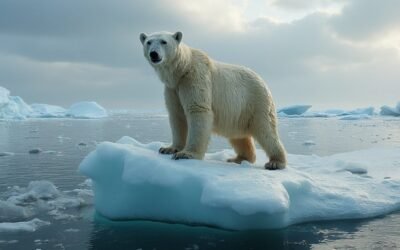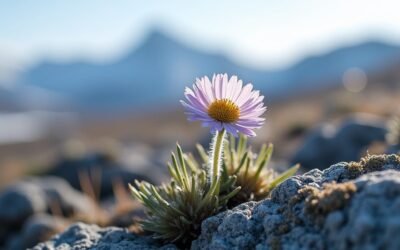Climate change has a profound impact on polar birds, changing their survival and breeding patterns. To begin with, species like the Emperor penguin are encountering habitat threats due to shrinking polar ice, which disrupts their breeding grounds. Additionally, birds such as the Arctic Tern are experiencing altered migration patterns. They now travel longer distances as their traditional stopover sites become unsuitable, influencing their timing and success in breeding. Lastly, the decline in food sources like krill and fish, closely linked with changes in sea ice and ocean temperatures, affects the food web essential for the survival of these birds. If you delve deeper, you'll discover more about their adaptation strategies.
Main Points
- Shrinking polar ice reduces Emperor penguins' primary food sources, threatening their survival.
- Altered migration patterns of Arctic Terns increase flight distances, affecting their reproductive success.
- Decline in krill and fish due to warming oceans impacts food availability for polar birds.
- Ivory gulls face heightened breeding challenges and competition due to loss of ice habitats.
- Unpredictable migration and breeding cycles in polar birds reflect severe climate impacts.
Shrinking Ice, Threatened Species
As polar ice shrinks, essential habitats for species like the Emperor penguin and Ivory gull are under severe threat. The effects of climate change on declining sea ice in polar regions mean more than just a change in scenery. It's leading to significant habitat loss for these birds, whose life cycles are intricately tied to the stability of the ice.
These changes disrupt the entire food chain. With ice disappearing, the platforms from which these birds hunt and nest are vanishing, forcing them to adapt quickly or face dire consequences. The Emperor penguin, known for its reliance on sea ice for breeding and molting, finds itself particularly vulnerable. As the ice recedes, so does the availability of their primary food sources, further straining their ability to thrive.
Similarly, the Ivory gull, which feeds and nests on ice, is experiencing increased competition as the spaces they depend on shrink. This competition not only affects their survival but also impacts their breeding success, which is critical for maintaining population numbers.
You're witnessing a dramatic reshaping of life in these icy habitats, where the balance of the ecosystem hangs delicately in the balance, pushed increasingly towards instability by the relentless progression of climate change.
Altered Migration Patterns
Polar birds like Arctic Terns now fly longer distances due to shifting climate conditions, altering their traditional migration patterns. This adaptation is necessary as they face the profound impacts of climate change, which reshapes their environments and survival strategies. As you observe these birds, you'll notice changes in the timing of their arrivals at breeding grounds, which can critically affect their reproductive success. They might arrive too early or too late, missing the best conditions for mating and nesting.
The migration patterns of these polar birds are becoming increasingly unpredictable. The synchrony of their migratory movements, once a reliable ritual, is now disrupted. This lack of coordination can lead to mismatches with peak food availability along their routes, directly impacting their survival rates. As their usual food stops become less reliable due to warmer temperatures, they're forced to either extend their routes or find new stopping points. This constant adjustment is a reflection of their resilience but also highlights the severe challenges they face.
You're witnessing a dynamic but troubling shift in how polar birds manage their life cycles in response to changing climate conditions. Their struggle mirrors the broader environmental shifts impacting species worldwide, underscoring the urgent need for thorough climate action.
Declining Food Sources
Climate change has led to a significant decline in the availability of krill and fish, essential food sources for polar birds, threatening their survival and reproductive success. As you investigate further into this issue, you'll find that several factors contribute to this troubling trend:
- Changes in sea ice: The reduction in sea ice due to rising ocean temperatures affects the habitat of krill and fish, leading to a decrease in their populations.
- Shifts in distribution: Warming oceans cause fish and krill to migrate to cooler waters, often away from areas where polar birds traditionally forage, complicating their feeding strategies.
- Impact on breeding cycles: The timing of food availability is important. As climate change disrupts the abundance of prey during critical breeding periods, birds struggle to find enough food to sustain their chicks.
- Overall food web alterations: Declines in krill and fish not only impact polar birds but also ripple through the food webs, affecting other wildlife dependent on these resources.
The interplay of these elements results in diminished foraging success for polar birds, threatening their ability to thrive and reproduce effectively in their harsh environments.
Frequently Asked Questions
How Are Arctic Birds Affected by Climate Change?
You're witnessing Arctic birds grappling with the impacts of climate change, including habitat loss due to melting sea ice. Their breeding timing, nesting disruptions, and altered migration patterns are closely tied to temperature sensitivity and sea ice dependency.
Food scarcity, increased competition, and predator shifts further challenge their survival. These disruptions are profound, illustrating the sensitive balance Arctic birds maintain within their rapidly changing ecosystems.
How Are Polar Species Affected by Climate Change?
You're witnessing how climate change impacts polar species. Ocean acidification and ice melt disrupt nesting and feeding patterns, causing migratory confusion and breeding cycle shifts.
Habitat loss from changing ice landscapes affects their survival, altering predatory balances and increasing disease susceptibility. These challenges are severe, leading to a decline in polar bird populations, fundamentally threatening biodiversity and ecosystem stability in their native icy domains.
What Are Some Examples of Polar Climate Change?
You're witnessing dramatic shifts in the polar regions, primarily due to climate change. Sea ice is melting, glaciers are retreating, and permafrost is thawing—all contributing to rising sea levels and ocean acidification.
These changes lead to more extreme weather patterns, significant habitat loss, and temperature fluctuations. Additionally, increased carbon emissions intensify these effects, causing widespread ecosystem disruption.
These transformations are pivotal in understanding the broader impacts of climate change on Earth's polar environments.
How Are Penguins and Polar Bears Affected by Climate Change?
Can you imagine a world where penguins and polar bears struggle to survive?
Climate change is causing ice habitat loss, disrupting penguin migration patterns and bear hunting abilities. Krill populations, crucial for the polar diet, are declining. This leads to breeding cycle disruptions and fat reserves depletion in both species.
Additionally, polar bears and penguins face increased thermal stress impacts and snow cover reduction, further challenging their existence in their rapidly changing environments.
How Is Climate Change Contributing to the Extinction Risks of Polar Bird Species?
Climate change is rapidly altering the Arctic ecosystem, leading to habitat loss and food scarcity. These changes increase *arctic bird extinction risks*, as species such as puffins and ivory gulls struggle to adapt. Rising temperatures disrupt breeding cycles, while diminishing sea ice reduces critical feeding grounds needed for survival and reproduction.
Conclusion
As you've seen, climate change casts a long shadow over polar birds. Shrinking ice disrupts habitats, altered migration patterns challenge survival, and declining food sources compound these threats.
While the situation seems critical, understanding these impacts prompts crucial conservation efforts. It's a race against time, and every action counts.
By addressing these changes, you're contributing to the preservation of these remarkable species, ensuring they don't become mere footnotes in Earth's extensive natural history.


